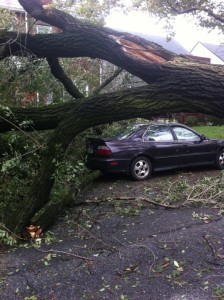 With Hurricane Irene having come and gone this weekend, residents of the East Coast are left picking up the pieces after a tropical storm that caused significant damage and 18 deaths, despite not quite living up to the hype that CNN promised.
With Hurricane Irene having come and gone this weekend, residents of the East Coast are left picking up the pieces after a tropical storm that caused significant damage and 18 deaths, despite not quite living up to the hype that CNN promised.
All in all, Hurricane Irene killed at least 18 people from Puerto Rico to Connecticut, caused an estimated $3 billion in damage and cut electric power to more than 4 million homes and businesses across the eastern U.S. Virginia itself suffered the second largest power outage in state history.
State Farm Insurance, one of the country’s largest auto insurers, reported over 500 auto insurance claims as of 3pm local time the day after the hurricane hit. Many more are expected to follow as homeowners and vehicle owners take stock of the damage and start checking their insurance policies.
Delaware was particularly badly hit, with winds over 70 miles per hour, which sent trees crashing onto cars and homes in the Wilmington suburb of Arden. Several buildings collapsed in Philadelphia, with many other states reporting property damage and fatalities. Mark McDonald, a spokesman for Mayor Michael Nutter in Philadelphia, said in a phone interview, “Between flooding and trees down, there is what you might call a mess.”
It’s Probably Too Late to Wonder if You’re Covered
If you live in Florida, you’re most likely covered for hurricane damage. However, if you’re from New Jersey you might not necessarily have had the right kind of cover, as these things happen less often and are therefore often seen as an unnecessary insurance cost.
The Maryland Insurance Administration strongly recommends that you take the following steps to determine if you have proper hurricane damage cover, and how to claim for payments in a way that will see you get your money as quickly as possible. Bear in mind that claiming for hurricane or natural disaster damage is a slightly different process from handling a car accident claim.
1) Call Your Insurer as soon as is practically possible. The lines will be busy, and you’ll probably have to sit on hold for up to an hour or more, but it’s better to just get it over and done with and speak to a human being about exactly what has happened, before you go through the effort of doing anything else.
2) Gather evidence of all of the damage that has occurred. Don’t move anything or clean anything up before you’ve taken pictures and videos. Treat it like a crime scene on CSI – if there is any doubt that the pictures you’ve sent in are not of the original damage, your claim will take longer to process.
3) Make a list of everything that is damaged, and its estimated value. It might be a pain, but if you are filing a claim then you will have to do it anyway. If you have any original receipts for items that are damaged, gather these together.
4) Prevent Further Damage – no matter what kind of cover you have, most insurance companies won’t cover “secondary damage”. This means that if your window was broken during the hurricane, and then two days later a possum came in and damaged your carpet, the insurance company will cover the window but not the carpet.
If windows are broken, cover them with plastic. If there’s water in the house, drain it as best you can – water damage caused after the fact might not be covered if you left it there for a few days. Do whatever you can to prevent further damage to your property, and don’t just assume that everything will be covered.
5) Check if you have a Hurricane Deductible – this is included in many comprehensive policies sold in hurricane-prone areas, so you might have it and not even know about it. There will still be a deductible to pay, but you should be able to get most of the damage done to your vehicle compensated.
Other general information provided by the administration includes:
- Weather-related damage, such as a tree limb falling on your car, is normally covered by most comprehensive policies. An insurance claims investigator will come out, take some pictures, and then reimburse you for the damage.
- If your car is a total loss, you will be reimbursed at the book value of your car before the damage, less your deductible.
- If you only have liability cover for your vehicle, and hurricane damage to it is not covered by any other policy explicitly, then you are probably out of luck.





